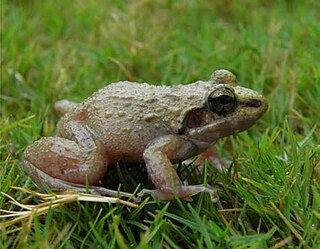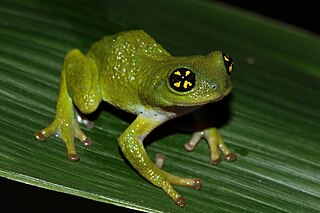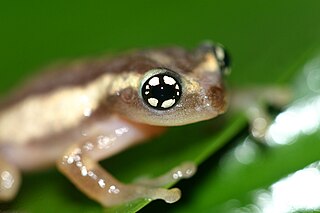
Indirana leithii is a species of frog in the family Ranixalidae. It is endemic to the northern Western Ghats of India. As currently defined, its range is restricted to the states of Maharashtra and southern Gujarat; earlier records elsewhere refer to other species.

Walkerana diplosticta, also known as the spotted leaping frog, Malabar Indian frog, rufous leaf-hopper frog, and Günther's frog, is a species of frog in the family Ranixalidae. It is endemic to the Western Ghats south of the Palghat Gap and only known with certainty from the states of Kerala and Tamil Nadu, India. Localities with confirmed records include the Kalakkad Mundanthurai Tiger Reserve.

Raorchestes chalazodes is a species of critically endangered frog in the family Rhacophoridae. Raorchestes chalazodes is a nocturnal and arboreal species found in the understorey of tropical moist evergreen forest and is endemic to the Western Ghats of India. The specific name chalazodes is composed of the Greek word χάλαζα (chalaza) meaning "lump" and -odes for the derived adjective, reflecting white granulation of the body.

Raorchestes luteolus is a species of frog in the family Rhacophoridae. It is endemic to the Western Ghats, India, where it is only known from the state of Karnataka. Many of the known populations are from the Kodagu district, known also by its anglicised former name of Coorg—hence the common name. It is also known from the Shimoga district in the Sharavathi basin where it was described as a new species, Philautus neelanethrus, but this is now considered to be a junior synonym of Raorchestes luteolus.

Raorchestes ponmudi is a species of frog in the family Rhacophoridae. It is endemic to the Western Ghats, India.

Raorchestes tinniens, also known as the spotted bush frog, black bush frog, and Rao's bubble-nest frog, is a species of frog in the family Rhacophoridae. It is endemic to the Nilgiri Hills, a part of the Western Ghats, in Tamil Nadu and Kerala, southern India. It has a rather complicated taxonomic history, and there is still an open issue whether Ixalus montanusGünther, 1876 from Kudremukh (Karnataka), now in synonymy with Raorchestes tinniens, is indeed a valid species.

Raorchestes tuberohumerus is a species of frog in the family Rhacophoridae. It is endemic to the Western Ghats, India, where it is found in Karnataka and Kerala states.

Raorchestes ochlandrae is a species of shrub frog in the family Rhacophoridae. It is endemic to the Western Ghats, India. This species of the oriental shrub frog was first described from Kakkayam Reserve Forest of Calicut district, Kerala state, in the southern Western Ghats in 2007 but has since been recorded at many other sites along the Western Ghats. The specific name ochlandrae refers to microhabitat of the species, bamboo Ochlandra setigera.

Raorchestes anili is a species of frog in the family Rhacophoridae.

Raorchestes dubois or the Koadaikanal bush frog is a species of frog in the family Rhacophoridae.

Raorchestes resplendens, the resplendent shrubfrog, is a critically endangered species of frog belonging to the family Rhacophoridae endemic to the high altitude region around the south Indian peak of Anaimudi. It has extremely short limbs and numerous macroglands and was discovered from the Anamudi summit in the Western Ghats of Kerala, India and is known only from the Eravikulam National Park.

Raorchestes is a genus of frogs in the subfamily Rhacophorinae that are found in mountainous regions of South Asia, Southeast Asia, and southern China. A recent study places Raorchestes as a sister taxon of Pseudophilautus. Before the description of the genus in 2010, species now in Raorchestes had been assigned to genera Ixalus, Philautus, and Pseudophilautus.

Raorchestes akroparallagi is a species of frogs in the family Rhacophoridae.

Raorchestes kakachi is a species of frogs in the family Rhacophoridae. It is endemic to the southern Western Ghats of India. The specific name kakachi refers to the type locality from where the species was described.

Indirana chiravasi is a species of frog endemic to the Western Ghats of India. It is only known from its type locality, the laterite plateaus by the hill-station of Amboli, Maharashtra. It was described in 2014 by a team of three scientists from IISER, Pune and MES Abasaheb Garware College.

Beddomixalus is a monotypic genus of frogs in the family Rhacophoridae. The only described species, Beddomixalus bijui, is endemic to the Western Ghats, India. Its name is derived from a combination of the cognomen of Richard Henry Beddome, in honour of his work on the amphibian diversity of the Western Ghats, as well as Ixalus, which is often used as a suffix for names of rhacophorid genera.
Pseudophilautus karunarathnai is a species of frogs in the family Rhacophoridae, endemic to Sri Lanka.
Pseudophilautus newtonjayawardanei is a species of frogs in the family Rhacophoridae, endemic to Sri Lanka.

Raorchestes honnametti is a species of frog in the family Rhacophoridae that is described from the Biligiri Rangaswamy Tiger Reserve in Karnataka.
Raorchestes kollimalai, the Kollimalai bush frog, is a species of frog in the family Rhacophoridae. It is endemic to India. Scientists have observed it its type locality in the Western Ghat mountains, about 1100 meters above sea level.


















